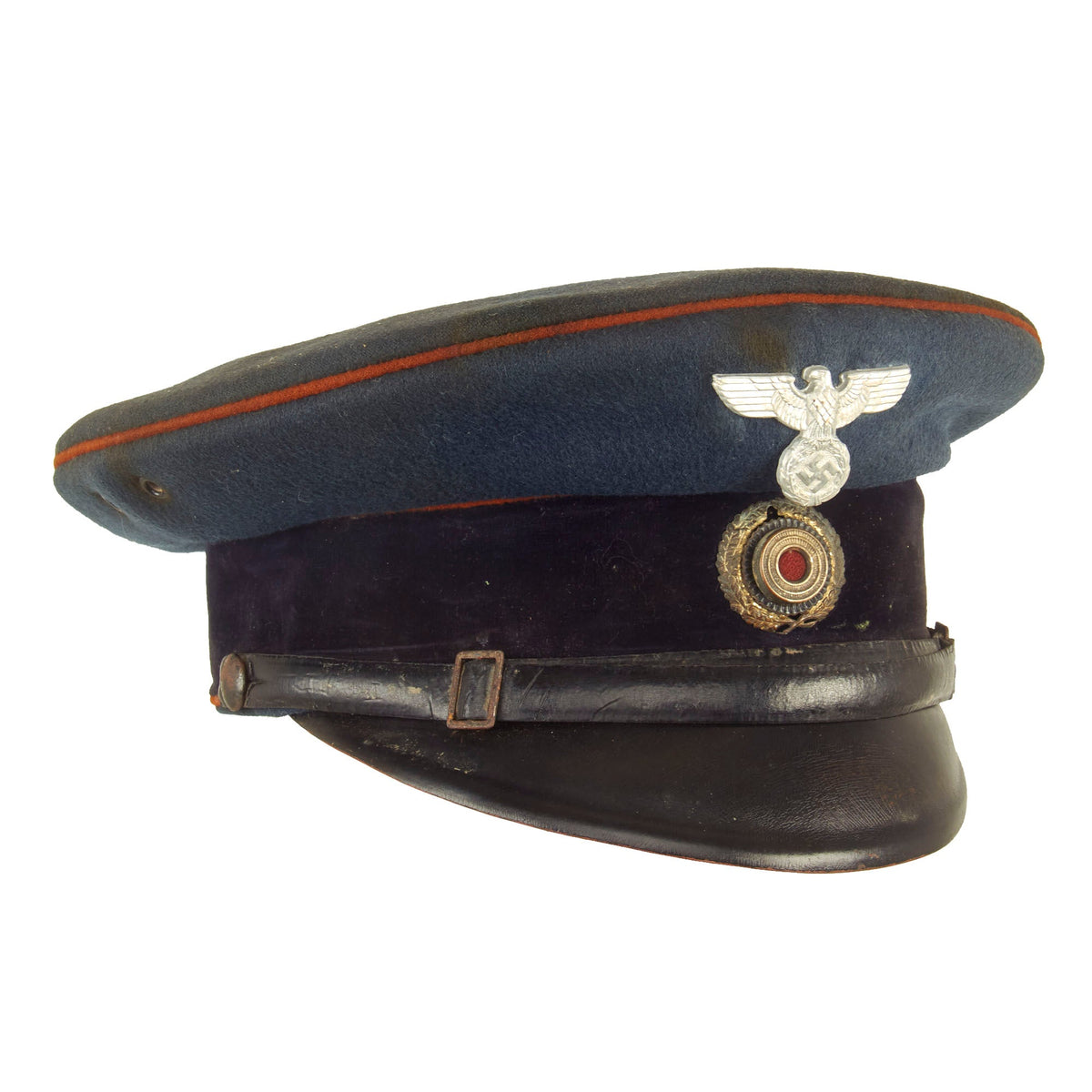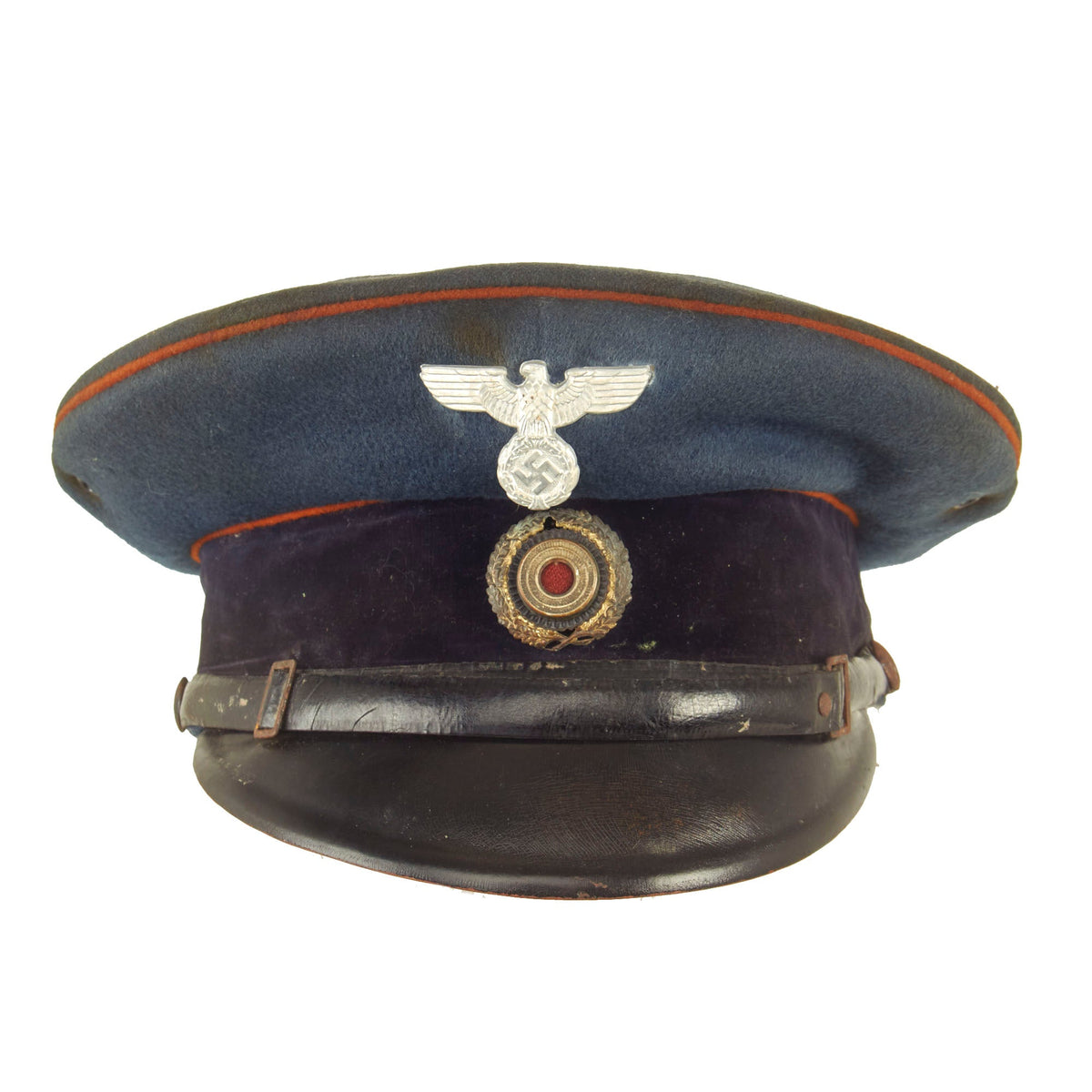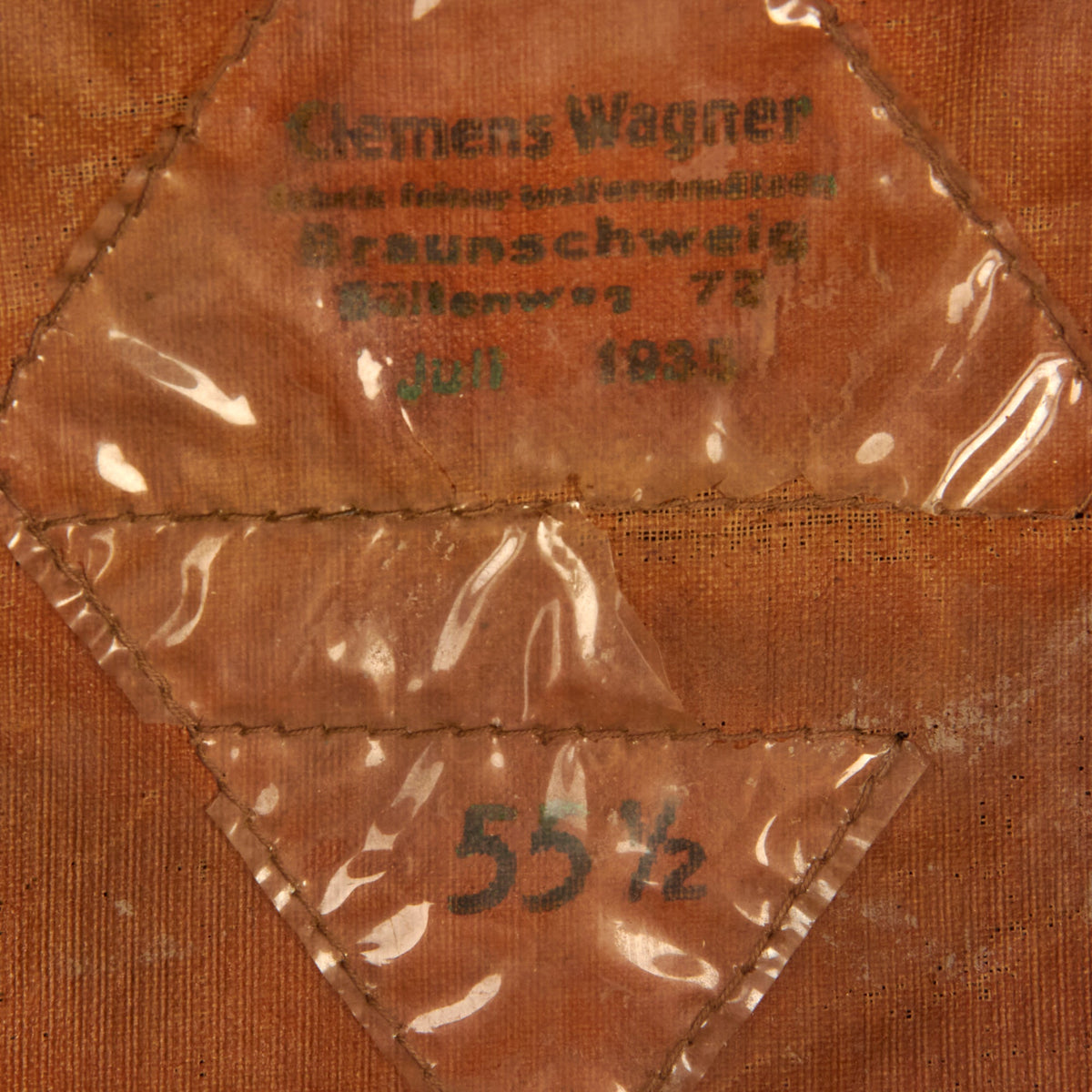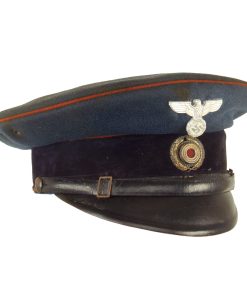Original German WWII 1935 Reichspost Imperial Mail 1935 Dated Postschaffner Schirmmütze Visor Cap by Clemens Wagner – Size 55 ½ Original Items
$ 375,00 $ 112,50
Original Items: Only One Grouping Available. Reichspost, “Imperial Mail”, was the name of the postal service of Germany from 1866 to 1945. In the Second World War the Reichspost authority spread out to the Polish areas annexed by NSDAP Germany, such as the Reichsgau Wartheland, the Reichsgau Danzig-Westpreußen, and the Polish General Government. In 1941 postal codes were introduced. The Feldpost military mail organization of the Wehrmacht not only served Army, Luftwaffe and Kriegsmarine service members, but also SS-Verfügungstruppen, Waffen-SS and Reichsarbeitsdienst members in the field, becoming the general postal authority of the occupied territories. Deliveries were more and more affected by the advance of Allied troops from January 1945 on. The Reichspost finally ceased to function with the German Instrument of Surrender on May 8. The last Reichspostminister Julius Dorpmüller, a member of the Flensburg Government, was arrested two weeks later, and governmental authority was officially taken over by the Allied Control Council with the Berlin Declaration of June 5.
This lovely service used visor cap is attributed to a Postschaffner, or “Post Conductor” as it translates to. The blue “doeskin” wool visor is in lovely condition and features the standard orange piping around the crown, with a stamped aluminum NSDAP eagle clutching a mobile swas in its talons on the front peak of the crown. The cap band is blue velvet plush material, with orange piping on either side, and bears a lovely wreathed cockade beneath that. Both pebbled buttons on the side for the chin strap are present as well as the decorative chin strap. The black vulkanfibre visor has a lovely pattern of crazing and checking on the the top, and is brown on the underside.
The interior is lined with light brown / orange “service cloth”, similar to oil cloth, and still has a mostly intact celluloid diamond “sweat shield” on the top. There is some tearing to the lining, but it still has the full maker markings on the inside:
Clemens Wagner
Fabrik feiner Uniformmützen
Braunschweig
Bültenweg 72
Juli 1935
55 ½
The interior is still fitted with a brown leather sweatband, which is in good condition, having gotten stiff over the years. The stitching that holds it in place is rotting out in the back, not unexpected for a cap that has seen a lot of service.
Overall condition is very good, showing some lovely period wear. It was issued July 1935, and probably saw service for much of the pre-war years, possibly still being in service during the war.
Comes more than ready for display!
Deutsche Reichspost
Upon the Austro-Prussian War of 1866 and the break-up of the German Confederation in the Peace of Prague, the North German Confederation was established, instigated by the Prussian minister-president Otto von Bismarck. Originally a military alliance, it evolved to a federation with the issuing of a constitution with effect from 1 July 1867. In the course of the war, Prussian troops had occupied the Free City of Frankfurt and the King of Prussia (later to become German Emperor) had purchased the remnants of the Thurn-und-Taxis Post organization. According to article 48, the federal area of the Northern German states, de facto an enlarged Prussia, came under the united postal authority, led by director Heinrich von Stephan.
With the German unification upon the Franco-Prussian War of 1870–1871, the Deutsche Reichspost was established as a state monopoly and became the official national postal authority of the German Empire including the annexed province of Alsace-Lorraine. Its official name was Kaiserliche Post und Telegraphenverwaltung. The Southern German federated states of Baden (until 1872), Württemberg (until 1902) and Bavaria initially maintained separate state post authorities that nevertheless were integrated into the nationwide administration. On 1 January 1876 a Reichspostamt under Postmaster General von Stephan was split-off from Bismarck’s Reich Chancellery as a government agency in its own right. In the First World War, a Reichsabgabe tax was levied on the postal traffic from 1 August 1916 in order to finance the war expenses.
With the establishment of the Weimar Republic upon the German Revolution of 1918–1919, the former Reichspostamt in Berlin became the Reichspostministerium. After the hyperinflation period, the Deutsche Reichspost (DRP) agency was again spun off in 1924 and operated as a state-owned enterprise. On 2 June 1932 Paul Freiherr von Eltz-Rübenach was appointed Reichspost Minister by Chancellor Franz von Papen and he maintained his office upon the Machtergreifung of the NSDAP Party in 1933, “assisted” by NSDAP state secretary Wilhelm Ohnesorge. The postal area was significantly enlarged with the incorporation of the Saar territory in 1935, the Austrian Anschluss in 1938, and the annexation of the Sudetenland according to the Munich Agreement. It was during this time that the Reichspost installed the first public videophone.
In the Second World War the Reichspost authority spread out to the Polish areas annexed by Germany, such as the Reichsgau Wartheland, the Reichsgau Danzig-Westpreußen, and the Polish General Government. In 1941 postal codes were introduced. The Feldpost military mail organization of the Wehrmacht not only served Army, Luftwaffe and Kriegsmarine service members, but also SS-Verfügungstruppen, Waffen-SS and Reichsarbeitsdienst members in the field, becoming the general postal authority of the occupied territories. Deliveries were more and more affected by the advance of Allied troops from January 1945 on. The Reichspost finally ceased to function with the German Instrument of Surrender on May 8. The last Reichspostminister Julius Dorpmüller, a member of the Flensburg Government, was arrested two weeks later, and governmental authority was officially taken over by the Allied Control Council with the Berlin Declaration of June 5.
The Reichspost was initially replaced by Allied-controlled postal authorities that provided mail services in the occupation zones. From 1947 a united agency served the British-American Bizone area. With the emergence of two German states, the Deutsche Bundespost (German federal post office) was established in West Germany, and the Deutsche Post in East Germany. In addition, there was a separate Deutsche Bundespost Berlin for West Berlin, as well as the Saar postal authority (1947–1956).
After the reunification of Germany in 1990, the state-owned Bundespost continued to function as the sole provider of postal services until 1995, when the postal, telecommunications, and banking divisions were spun off as separate entities. The Deutsche Bundespost eventually became Deutsche Post AG, a share holding company, later reintegrating the Postbank, and Deutsche Telekom.
Fast Shipping with Professional Packaging
Thanks to our longstanding association with UPS FedEx DHL, and other major international carriers, we are able to provide a range of shipping options. Our warehouse staff is expertly trained and will wrap your products according to our exact and precise specifications. Prior to shipping, your goods will be thoroughly examined and securely secured. We ship to thousands clients each day across multiple countries. This shows how we're dedicated to be the largest retailer on the internet. Warehouses and distribution centres can be located throughout Europe as well as the USA.
Note: Orders with more than one item will be assigned a processing date depending on the item.
Before shipping before shipping, we'll conduct a thorough inspection of the items you have ordered. Today, the majority of orders will be delivered within 48 hours. The delivery time will be between 3-7 days.
Returns
The stock is dynamic and we cannot completely manage it because multiple stakeholders are involved, including our factory and warehouse. So the actual stock may alter at any time. It's possible that you may not receive your order once the order has been made.
Our policy is valid for a period of 30 days. If you don't receive the product within 30 days, we are not able to issue a refund or an exchange.
You can only return an item if it is unused and in the same state as the day you received it. You must have the item in its original packaging.
Related products
Uncategorized
Uncategorized
Uncategorized
Uncategorized
Uncategorized
Uncategorized
Uncategorized
Uncategorized
Uncategorized
Uncategorized
Uncategorized
Uncategorized
Uncategorized
Uncategorized
Uncategorized
Uncategorized
Armoured Fighting Vehicles of the World: AFVs of World War One (Hardcover Book) New Made Items
Uncategorized
Uncategorized












































































